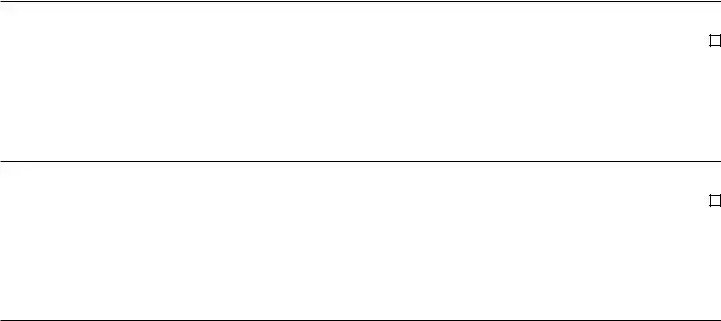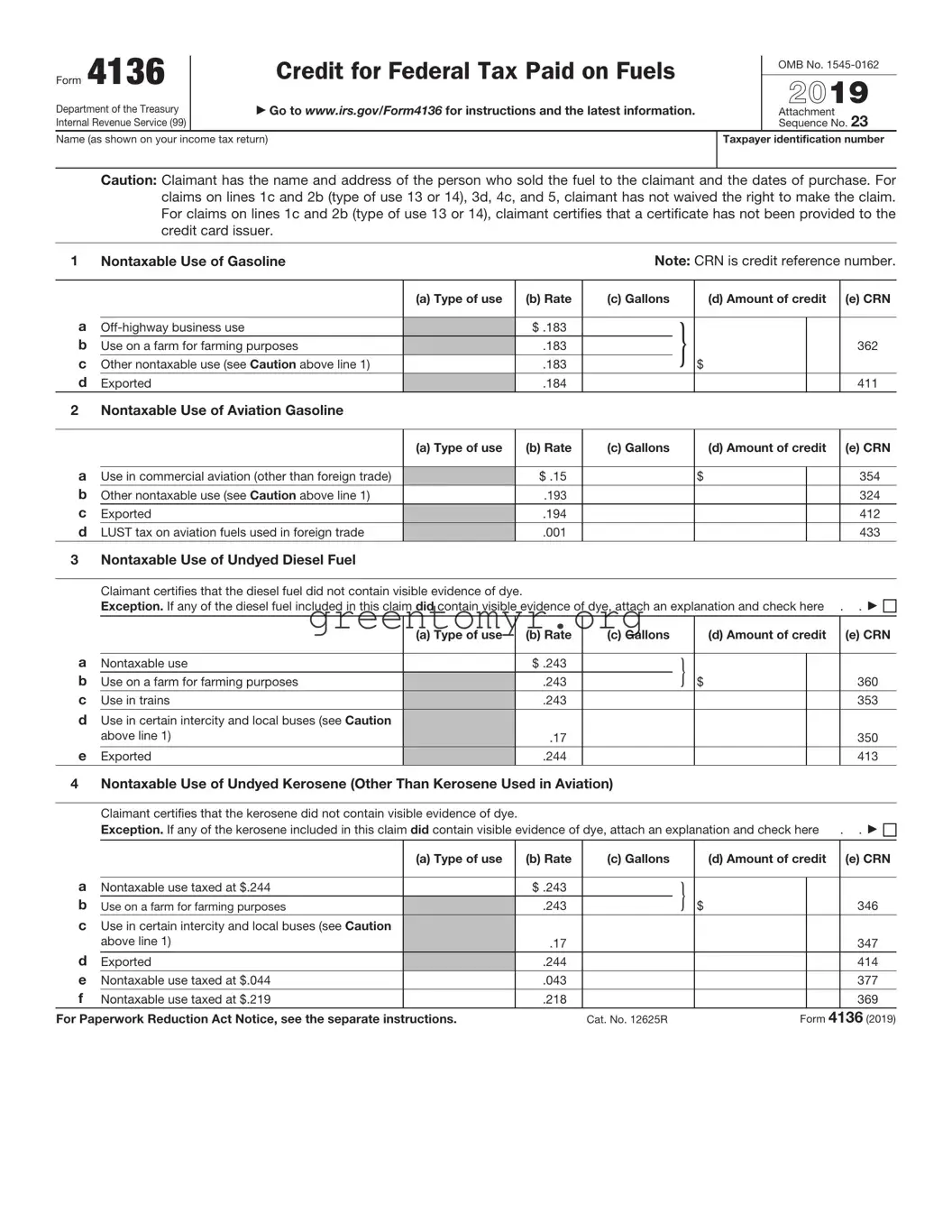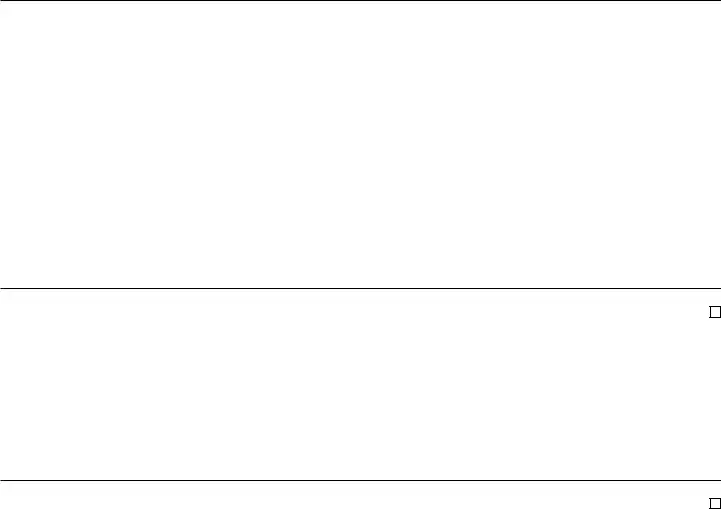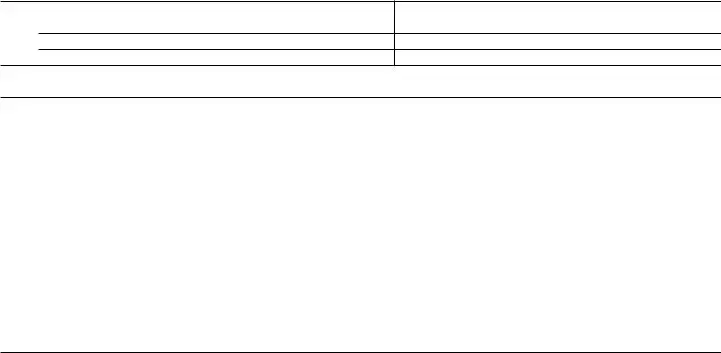Form 4136 |
|
Credit for Federal Tax Paid on Fuels |
|
OMB No. 1545-0162 |
|
|
|
|
|
2019 |
Department of the Treasury |
|
Go to www.irs.gov/Form4136 for instructions and the latest information. |
|
|
|
Attachment |
Internal Revenue Service (99) |
|
|
|
Sequence No. 23 |
Name (as shown on your income tax return) |
|
Taxpayer identification number |
|
|
|
|
|
Caution: Claimant has the name and address of the person who sold the fuel to the claimant and the dates of purchase. For claims on lines 1c and 2b (type of use 13 or 14), 3d, 4c, and 5, claimant has not waived the right to make the claim. For claims on lines 1c and 2b (type of use 13 or 14), claimant certifies that a certificate has not been provided to the credit card issuer.
1 Nontaxable Use of Gasoline |
|
Note: CRN is credit reference number. |
|
|
|
|
|
|
|
|
|
|
|
(a) Type of use |
(b) Rate |
(c) Gallons |
(d) Amount of credit |
(e) CRN |
a |
|
|
|
|
|
|
|
|
Off-highway business use |
|
$ .183 |
|
} |
|
|
|
b |
Use on a farm for farming purposes |
|
.183 |
|
|
|
362 |
c |
Other nontaxable use (see Caution above line 1) |
|
.183 |
|
$ |
|
|
d |
Exported |
|
.184 |
|
|
|
|
411 |
2Nontaxable Use of Aviation Gasoline
|
|
(a) Type of use |
(b) Rate |
(c) Gallons |
|
(d) Amount of credit |
(e) CRN |
a |
|
|
|
|
|
|
|
|
Use in commercial aviation (other than foreign trade) |
|
$ .15 |
|
$ |
|
|
354 |
b |
Other nontaxable use (see Caution above line 1) |
|
.193 |
|
|
|
|
324 |
c |
Exported |
|
.194 |
|
|
|
|
412 |
d |
LUST tax on aviation fuels used in foreign trade |
|
.001 |
|
|
|
|
433 |
3Nontaxable Use of Undyed Diesel Fuel
Claimant certifies that the diesel fuel did not contain visible evidence of dye.
|
Exception. If any of the diesel fuel included in this claim did contain visible evidence of dye, attach an explanation and check here . . |
|
|
(a) Type of use |
(b) Rate |
(c) Gallons |
(d) Amount of credit |
(e) CRN |
a |
|
|
|
|
|
|
|
|
Nontaxable use |
|
$ .243 |
|
} |
|
|
|
b |
Use on a farm for farming purposes |
|
.243 |
|
$ |
|
360 |
c |
Use in trains |
|
.243 |
|
|
|
|
353 |
d Use in certain intercity and local buses (see Caution |
|
|
|
|
|
|
|
|
above line 1) |
|
.17 |
|
|
|
|
350 |
e |
Exported |
|
.244 |
|
|
|
|
413 |
4Nontaxable Use of Undyed Kerosene (Other Than Kerosene Used in Aviation)
Claimant certifies that the kerosene did not contain visible evidence of dye.
|
Exception. If any of the kerosene included in this claim did contain visible evidence of dye, attach an explanation and check here |
. . |
|
|
(a) Type of use |
(b) Rate |
(c) Gallons |
|
(d) Amount of credit |
(e) CRN |
a |
|
|
|
|
|
|
|
|
|
Nontaxable use taxed at $.244 |
|
$ .243 |
|
} |
|
|
|
|
b |
Use on a farm for farming purposes |
|
.243 |
|
$ |
|
|
346 |
c |
Use in certain intercity and local buses (see Caution |
|
|
|
|
|
|
|
|
|
above line 1) |
|
.17 |
|
|
|
|
|
347 |
d |
Exported |
|
.244 |
|
|
|
|
|
414 |
e |
Nontaxable use taxed at $.044 |
|
.043 |
|
|
|
|
|
377 |
f |
Nontaxable use taxed at $.219 |
|
.218 |
|
|
|
|
|
369 |
For Paperwork Reduction Act Notice, see the separate instructions. |
|
Cat. No. 12625R |
Form 4136 (2019) |

5Kerosene Used in Aviation (see Caution above line 1)
|
|
|
(a) Type of use |
(b) Rate |
(c) Gallons |
(d) Amount of credit |
(e) CRN |
|
|
|
|
|
|
|
|
|
|
a Kerosene used in commercial aviation (other than |
|
|
|
|
|
|
|
|
foreign trade) taxed at $.244 |
|
$ .200 |
|
$ |
|
417 |
|
b Kerosene used in commercial aviation (other than |
|
|
|
|
|
|
|
|
foreign trade) taxed at $.219 |
|
.175 |
|
|
|
355 |
|
c Nontaxable use (other than use by state or local |
|
|
|
|
|
|
|
|
government) taxed at $.244 |
|
.243 |
|
|
|
346 |
|
d Nontaxable use (other than use by state or local |
|
|
|
|
|
|
|
|
government) taxed at $.219 |
|
.218 |
|
|
|
369 |
|
e |
LUST tax on aviation fuels used in foreign trade |
|
.001 |
|
|
|
433 |
6 |
|
Sales by Registered Ultimate Vendors of Undyed Diesel Fuel |
|
Registration No. |
|
|
|
Claimant certifies that it sold the diesel fuel at a tax-excluded price, repaid the amount of tax to the buyer, or has obtained the written consent of the buyer to make the claim. Claimant certifies that the diesel fuel did not contain visible evidence of dye.
Exception. If any of the diesel fuel included in this claim did contain visible evidence of dye, attach an explanation and check here . .
|
|
(b) Rate |
(c) Gallons |
|
(d) Amount of credit |
(e) CRN |
|
|
|
|
|
|
|
a |
Use by a state or local government |
$ .243 |
|
$ |
|
|
360 |
b |
Use in certain intercity and local buses |
.17 |
|
|
|
|
350 |
7 Sales by Registered Ultimate Vendors of Undyed Kerosene
(Other Than Kerosene For Use in Aviation)
Claimant certifies that it sold the kerosene at a tax-excluded price, repaid the amount of tax to the buyer, or has obtained the written consent of the buyer to make the claim. Claimant certifies that the kerosene did not contain visible evidence of dye.
|
Exception. If any of the kerosene included in this claim did contain visible evidence of dye, attach an explanation and check here . . |
|
|
(b) Rate |
(c) Gallons |
(d) Amount of credit |
(e) CRN |
a |
|
|
|
|
|
|
|
Use by a state or local government |
$ .243 |
|
} |
|
|
|
b |
Sales from a blocked pump |
.243 |
|
$ |
|
346 |
c |
Use in certain intercity and local buses |
.17 |
|
|
|
|
347 |
8 |
Sales by Registered Ultimate Vendors of Kerosene For Use in Aviation |
Registration No. |
|
|
|
Claimant sold the kerosene for use in aviation at a tax-excluded price and has not collected the amount of tax from the buyer, repaid the amount of tax to the buyer, or has obtained the written consent of the buyer to make the claim. See the instructions for additional information to be submitted.
|
|
(a) Type of use |
(b) Rate |
(c) Gallons |
(d) Amount of credit |
(e) CRN |
a |
|
|
|
|
|
|
|
Use in commercial aviation (other than foreign trade) |
|
|
|
|
|
|
|
taxed at $.219 |
|
$ .175 |
|
$ |
|
355 |
b |
Use in commercial aviation (other than foreign trade) |
|
|
|
|
|
|
|
taxed at $.244 |
|
.200 |
|
|
|
417 |
c |
Nonexempt use in noncommercial aviation |
|
.025 |
|
|
|
418 |
d |
Other nontaxable uses taxed at $.244 |
|
.243 |
|
|
|
346 |
e |
Other nontaxable uses taxed at $.219 |
|
.218 |
|
|
|
369 |
f |
LUST tax on aviation fuels used in foreign trade |
|
.001 |
|
|
|
433 |
Form 4136 (2019) |
Page 3 |
9 Reserved for future use |
Registration No. |
aReserved for future use b Reserved for future use
(b) Rate |
(c) Gallons |
(d) Amount of credit |
(e) CRN |
|
of alcohol |
|
|
|
|
|
|
|
|
|
|
$ |
|
|
|
|
|
|
|
10 Biodiesel or Renewable Diesel Mixture Credit |
Registration No. |
Biodiesel mixtures. Claimant produced a mixture by mixing biodiesel with diesel fuel. The biodiesel used to produce the mixture met ASTM D6751 and met EPA’s registration requirements for fuels and fuel additives. The mixture was sold by the claimant to any person for use as a fuel or was used as a fuel by the claimant. Claimant has attached the Certificate for Biodiesel and, if applicable, the Statement of Biodiesel Reseller. Renewable diesel mixtures. Claimant produced a mixture by mixing renewable diesel with liquid fuel (other than renewable diesel). The renewable diesel used to produce the renewable diesel mixture was derived from biomass, met EPA’s registration requirements for fuels and fuel additives, and met ASTM D975, D396, or other equivalent standard approved by the IRS. The mixture was sold by the claimant to any person for use as a fuel or was used as a fuel by the claimant. Claimant has attached the Certificate for Biodiesel and, if applicable, Statement of Biodiesel Reseller, both of which have been edited as discussed in the instructions for line 10. See the instructions for line 10 for information about renewable diesel used in aviation.
|
|
(b) Rate |
(c) Gallons |
(d) Amount of credit |
(e) CRN |
|
|
|
of biodiesel or |
|
|
|
|
|
|
renewable diesel |
|
|
|
|
|
|
|
|
|
a |
Biodiesel (other than agri-biodiesel) mixtures |
$1.00 |
|
$ |
|
388 |
b |
Agri-biodiesel mixtures |
1.00 |
|
|
|
390 |
c |
Renewable diesel mixtures |
1.00 |
|
|
|
307 |
11Nontaxable Use of Alternative Fuel
Caution: There is a reduced credit rate for use in certain intercity and local buses (type of use 5). See instructions.
|
|
(a) Type of use |
(b) Rate |
(c) Gallons, |
|
(d) Amount |
(e) CRN |
|
|
|
|
or gasoline |
|
of credit |
|
|
|
|
|
or diesel gallon |
|
|
|
|
|
|
|
|
equivalents |
|
|
|
|
a |
|
|
|
|
|
|
|
|
Liquefied petroleum gas (LPG) (see instructions) |
|
$ .183 |
|
$ |
|
|
419 |
b |
“P Series” fuels |
|
.183 |
|
|
|
|
420 |
c |
Compressed natural gas (CNG) (see instructions) |
|
.183 |
|
|
|
|
421 |
d |
Liquefied hydrogen |
|
.183 |
|
|
|
|
422 |
e |
Fischer-Tropsch process liquid fuel from coal |
|
|
|
|
|
|
|
|
(including peat) |
|
.243 |
|
|
|
|
423 |
f |
Liquid fuel derived from biomass |
|
.243 |
|
|
|
|
424 |
g |
Liquefied natural gas (LNG) (see instructions) |
|
.243 |
|
|
|
|
425 |
h |
Liquefied gas derived from biomass |
|
.183 |
|
|
|
|
435 |
12 |
Alternative Fuel Credit |
|
Registration No. |
|
|
|
|
|
|
|
|
|
|
|
|
|
|
|
(b) Rate |
(c) Gallons, or |
|
(d) Amount of credit |
(e) CRN |
|
|
|
|
gasoline or diesel |
|
|
|
|
|
|
|
|
gallon equivalents |
|
|
|
|
a |
|
|
|
|
|
|
|
|
Liquefied petroleum gas (LPG) (see instructions) |
$ .50 |
|
$ |
|
|
426 |
b |
“P Series” fuels |
.50 |
|
|
|
|
427 |
c |
Compressed natural gas (CNG) (see instructions) |
.50 |
|
|
|
|
428 |
d |
Liquefied hydrogen |
.50 |
|
|
|
|
429 |
e |
Fischer-Tropsch process liquid fuel from coal (including peat) |
.50 |
|
|
|
|
430 |
f |
Liquid fuel derived from biomass |
.50 |
|
|
|
|
431 |
g |
Liquefied natural gas (LNG) (see instructions) |
.50 |
|
|
|
|
432 |
h |
Liquefied gas derived from biomass |
.50 |
|
|
|
|
436 |
i |
Compressed gas derived from biomass |
.50 |
|
|
|
|
437 |
Form 4136 (2019) |
|
|
|
|
Page 4 |
13 |
|
Registered Credit Card Issuers |
|
Registration No. |
|
|
|
|
|
|
|
|
|
|
|
|
|
(b) Rate |
(c) Gallons |
(d) Amount of credit |
(e) CRN |
|
|
|
|
|
|
|
|
a |
Diesel fuel sold for the exclusive use of a state or local government |
$ .243 |
|
$ |
|
360 |
|
b |
Kerosene sold for the exclusive use of a state or local government |
.243 |
|
|
|
346 |
|
c Kerosene for use in aviation sold for the exclusive use of a state or local |
|
|
|
|
|
|
|
government taxed at $.219 |
.218 |
|
|
|
369 |
14Nontaxable Use of a Diesel-Water Fuel Emulsion
Caution: There is a reduced credit rate for use in certain intercity and local buses (type of use 5). See instructions.
|
|
(a) Type of use |
(b) Rate |
(c) Gallons |
(d) Amount of credit |
(e) CRN |
a |
|
|
|
|
|
|
|
Nontaxable use |
|
$ .197 |
|
$ |
|
309 |
b |
Exported |
|
.198 |
|
|
|
306 |
15 Diesel-Water Fuel Emulsion Blending |
|
Registration No. |
|
|
|
(b) Rate |
(c) Gallons |
|
(d) Amount of credit |
(e) CRN |
$ .046 |
|
$ |
|
310 |
|
|
|
16 |
Exported Dyed Fuels and Exported Gasoline Blendstocks |
|
|
|
|
|
|
|
|
|
|
|
|
|
|
|
|
|
(b) Rate |
(c) Gallons |
|
(d) Amount of credit |
(e) CRN |
|
|
|
|
|
|
|
|
|
a Exported dyed diesel fuel and exported gasoline blendstocks taxed |
|
|
|
|
|
|
|
|
at $.001 |
$ .001 |
|
|
|
$ |
|
415 |
b |
Exported dyed kerosene |
.001 |
|
|
|
|
|
416 |
17 |
Total income tax credit claimed. Add lines 1 through 16, column (d). Enter here and on |
|
|
|
|
|
|
Schedule 3 (Form 1040 or 1040-SR), line 12; Form 1120, Schedule J, line 20b; Form 1120-S, |
|
|
|
|
|
|
line 23c; Form 1041, Schedule G, line 16b; or the proper line of other returns . . |
. . |
|
17 |
$ |
|
|
Form 4136 (2019)




